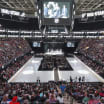Two perfect trading partners came together Wednesday when the Edmonton Oilers traded high-scoring left wing Taylor Hall to the New Jersey Devils for defenseman Adam Larsson.
Finishing 30th in the NHL with 182 non-shootout goals and 24.4 shots per game in 2015-16, the Devils needed some scoring. In contrast, the Oilers were 27th in the NHL with 242 goals allowed and tied for 26th with 31.1 shots allowed per game, and needed some help on defense. Both teams came out of the trade with a player whose talents were required urgently.
Hall, Larsson fill needs for Devils, Oilers
New Jersey adds needed offense; Edmonton gets defensive upgrade


















